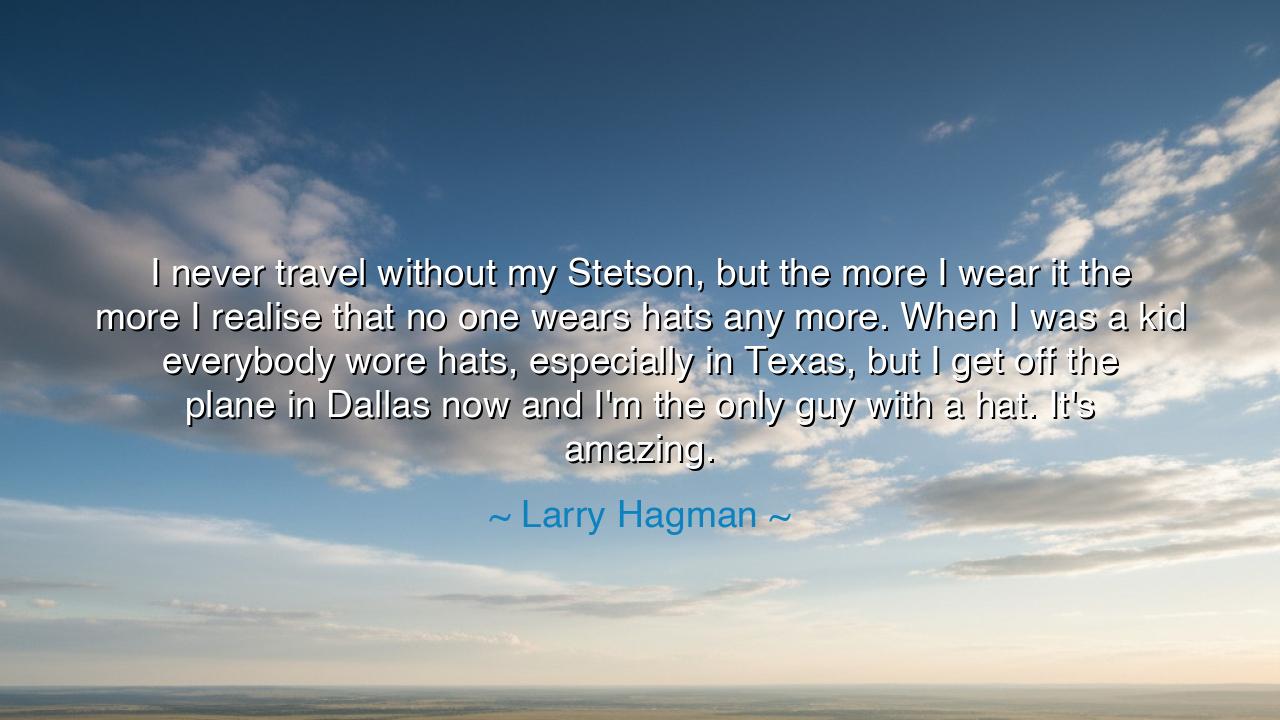
I never travel without my Stetson, but the more I wear it the
I never travel without my Stetson, but the more I wear it the more I realise that no one wears hats any more. When I was a kid everybody wore hats, especially in Texas, but I get off the plane in Dallas now and I'm the only guy with a hat. It's amazing.






Larry Hagman, in recalling his own life, once declared: “I never travel without my Stetson, but the more I wear it the more I realise that no one wears hats any more. When I was a kid everybody wore hats, especially in Texas, but I get off the plane in Dallas now and I'm the only guy with a hat. It's amazing.” Though his words may seem lighthearted, they carry the echo of a profound truth: the passage of time reshapes our customs, and what once bound us together in tradition often fades into memory. His Stetson is not merely a hat—it is a banner of identity, a relic of continuity, and a symbol of the tension between memory and modernity.
To understand this utterance, we must look first at Hagman himself, the actor who embodied the oil-soaked grandeur of Texas through his role in Dallas. The Stetson hat was more than fashion in that land; it was a mark of belonging, of heritage, of pride in a rugged identity. For Hagman, to travel without it would be to travel without a piece of himself. Yet his astonishment at finding himself alone in its wearing reveals a deeper ache: the traditions that once unified a people have slipped away, leaving the bearer of memory standing solitary in a crowd that has forgotten.
The heart of his quote speaks to the fading of collective symbols. In times past, hats were more than garments—they were extensions of dignity, of status, of community. In Texas, the cowboy hat was as much a declaration of roots as it was a shield from the sun. But as the modern world marched forward, practicality gave way to convenience, and fashion drifted into new forms. Hagman’s words are not mere nostalgia; they are a meditation on the reality that cultures evolve, and that which was once universal can vanish within a single lifetime.
History, too, shows us this pattern. In the early 20th century, nearly every man in the great cities of the West wore a hat. Presidents were crowned in fedoras, workers went to their labors in flat caps, and ladies shaded themselves in bonnets and veils. Yet, after the mid-century, the custom dissolved, hastened by changing fashions, the rise of the automobile, and the simplicity of bare-headed life. President John F. Kennedy himself, once appearing without a hat at his inauguration, marked the turning of the tide. The people followed, and within a generation, the sea of hats had vanished from the streets. Hagman’s reflection stands as living testimony to this transformation.
But his words are not merely about hats—they are about change, about the loneliness of holding to tradition when the world has moved on. To wear the Stetson in a land where no one else does is to stand as a guardian of memory, to declare: “I will not forget where I came from.” There is nobility in such steadfastness. Yet there is also sorrow, for one sees clearly how swiftly the wheel of time spins, grinding down the markers of identity that once seemed eternal. In this sense, Hagman’s amazement is not only about fashion—it is about mortality, about the fleeting nature of culture itself.
The lesson is this: hold fast to what is meaningful, even when the world no longer does. For traditions are more than garments; they are bridges to our ancestors, whispers of who we are, and lighthouses that guide us when the storms of change threaten to make us adrift. Do not discard your symbols lightly, for they carry within them stories that may otherwise be lost. Yet also, do not despise the changes of others, for every generation must forge its own way. The challenge is to balance memory with progress, roots with wings.
In practice, let us preserve the traditions that give us strength, whether through clothing, rituals, stories, or songs. Wear them proudly, even if you stand alone in them, for your faithfulness becomes a testament to history. At the same time, seek to understand the new ways of those who follow, for the river of culture never ceases to flow. Teach the young why the old ways mattered, but let them also teach you what the future demands. For the greatest wisdom lies not in clinging or abandoning, but in harmonizing the two.
Thus, Hagman’s quote, clothed in the image of a Stetson hat, becomes a teaching for all generations: cherish the symbols that shaped you, wear them with pride, but do not be surprised when the crowd has moved on. For the hat upon your head may no longer be the fashion of the many, but it may still be the crown of your soul. And in wearing it, you declare to time itself: I remember.






AAdministratorAdministrator
Welcome, honored guests. Please leave a comment, we will respond soon